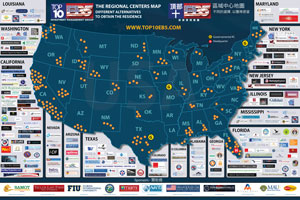The EB-5 visa program is set to expire later this year pending re-approval by Congress. Proponents of the program argue that the investor visas provide much-needed capital for economic development. Critics say it encourages a two-tier immigration system favoring the rich over those fleeing wars, persecution and poverty. Now, the decision on the EB 5 visa program ending rests in the hands of an administration that has been vocally conservative on the topic of immigration from the beginning.
EB 5 Visa Program Ending | What is the EB Program?
A federal immigration program responsible for funneling billions of dollars into major business development projects around the country is “teetering on the brink of political extinction” – at least according to some of its supporters.
Known as the immigrant investor visa, the EB5 visa program has been around since 1990. It became a major tool for project finance during the 2008 financial crisis when businesses, primarily real estate developers, were unable to get commercial loans. In the past 11 years alone, the program is estimated to have brought $18 billion in overseas cash into U.S. business development.
However, it will expire on September 30th unless Congress decides to renew it.
The EB-5 visa program, or employment-based fifth preference category provides a method for eligible foreign investors to become lawful permanent residents by investing money to create businesses in the United States that will employ American workers. The law requires that investors put up at least $1 million in a project that will employ no less than 10 American workers.
However, most investors who use the program invest in a Targeted Employment Area (TEA), which lowers the investment threshold to $500,000. In exchange, investors get American citizenship for themselves, their spouse and their children.
The program itself has had its fair share of benefits and controversies in its lifetime; however, recent immigration reform threatens to wipe it out almost entirely. Is there a chance of the EB 5 visa program ending? And if so, what will replace it?
2017 Immigration Reform Proposals
Currently more conservative immigration reforms, such as the RAISE Act, are being introduced as a replacement for programs like the EB5 Visa. The RAISE Act would eliminate the EB-5 employment category (along with all others), and instead enforce a merit based point system for those looking to gain visas.
The implications of the RAISE Act on EB5 investors would be substantial due to the need to accrue enough points – 30 in total. Unsurprisingly the bigger the investment the investor is willing to make, the more points he or she will receive – note that an investment of $1.35 million would only garner 6 points.
It should be noted that there is some difficulty in securing larger investments from foreign investors currently – as many opt for the lower thresholds of Regional Centers. The EB 5 visa program ending and being replaced with a much higher investment minimum could severely impact the number of foreign investors for U.S. projects.
The RAISE act would also require that investors have a role in actively managing their investment projects – something that is not currently required by any EB5 program, and a factor in its large growth over the years.
Needless to say, such an act could tie up potential investors in an even longer wait period for visa approval. The good news for EB5 supporters is that it is not anticipated that the RAISE Act will garner enough support to move forward – indeed it is expected to be “dead on arrival”.
However, it still begs the question about what the future of the EB5 immigration program will look like in an environment that is extremely focused on reducing immigration overall. Perhaps the EB 5 visa program ending is inevitable whether through the RAISE act or other legislation.
That being said – should the program remain at all? Let’s take a look at some of its pros and cons.
EB 5 Visa Program Ending | The Benefits of the EB5 Visa
Over the years, the EB5 program has evolved in both practice and importance. It is seen by many as a vital tool for creating jobs and helping the economy – what seems to be a win win.
Capital During Economic Downturn

During times like the great recession when money from banks is scarce, these investment pools serve as an opportunity for developers to continue to fund their projects.
Areas of focus for regional centers include those with high unemployment. Looking at the situation from a long-term perspective, these new developments would have the potential (and have since proven the ability) to create jobs and revitalize the economy in those areas.
A Boost to Real Estate With No Taxpayer Expense
Aside from job creation, EB5 investments also filled gaps in the space of affordable housing. Often investor funds go to commercial real estate projects and urban development. This and job creation is all accomplished while costing U.S. taxpayers nothing.
Federal job creation programs are much needed, and were seen after the recession such as with the American Recovery and Reinvestment Act. Unfortunately these programs can come at the cost of public money. One of the main benefits of the EB5 program was its ability to generate thousands of jobs without once influencing the taxpayers’ wallets.
The economic benefits garnered from EB5 investments over the life of the program are enormous. According to David Hirson & Partners LLP – “since 2008, more than $13 billion in foreign direct investment entered the United States economy through the EB-5 program. In addition, the EB-5 program added $9.62 billion to GDP and $2 billion to local state, and federal taxes – all while creating an average of 29,300 jobs per year.”
Overall, the EB5 program has made positive impacts on the U.S. economy and job creation in a variety of ways. This is felt particularly at a state level, where local communities are seeing the impact of foreign funding on businesses development.
Below is a chart diagramming the 5 states that have benefited the most from EB5 investments.
As you can clearly see, the EB5 visa program has generated significant economic benefits that have been dispersed throughout the country, contributing positively to the ongoing United States economic recovery.
EB5 Visa Fraud and Controversy

In effect, internationals can buy American citizenship if they are rich enough. To many critics this seems to only help the rich get richer, and does not place the focus on immigrants who are coming to the U.S. looking for a new start, or to escape horrendous circumstances.
This, among other loopholes, have made the program highly controversial. For wealthy foreigners, the EB5 visa program is by far and away the best bet for getting U.S. citizenship.
Other options, such as finding an employer of family-member to sponsor them, require extensive paperwork and take years on the short end. The EB5 visa, by comparison, is a relative breeze.
Wealthy Chinese investors make up the vast majority of the people using the EB-5 program: In 2014, 9,128 of the EB-5 visas issued were allocated to Chinese nationals, according to state department statistics.
The place of origin for the next highest visa allotments (at 225)? South Korea.
Rising Interest in EB5 Causes A Lag in Regulation
Foreign interest in the EB5 program has grown dramatically in recent years. Though the program was introduced in 1990 as part of a federal immigration overhaul, it wasn’t until the onset of the recession in 2007 that visa applications really started to increase. When domestic project financing for certain industries became hard to find, developers began considering international funding as an option.
Between 2007 and 2014, the program jumped from issuing a mere 700 visas to maxing out the program quota of 10,000. That quota was reached again in 2015, and once again in 2016.
The sudden and massive inflow of money meant that government efforts and regulations could not keep up. Subsequently, some of the most notable scandals regarding the program were related to EB5 visa fraud. Such issues have concerned potential investors being defrauded, and visas going to people convicted of money laundering among other crimes.
Does the EB5 Regional Center Lie at the Heart of the Controversy?
One of the biggest controversies results from the way in which the EB5 program has evolved. In 1992, to remedy the slow rate of applications from foreign investors, Congress allowed for the creation of “regional centers” or organizations that pool foreign investments.
Rather than needing to invest $1 million and directly create 10 jobs, foreign investors could now combine their money in a regional center. Today around 95% of all visas granted come through these centers.
Regional centers lie at the heart of much of the controversy surrounding the EB5 program, as well as that surrounding calls for the EB 5 visa program ending in the future. This is due to the way in which job creation through the centers is quantified. While the original program counted the direct jobs created as a result of foreign investment, regional centers are able to count indirect jobs.
An indirect job could be as vague as counting any raise in employment for businesses surrounding the EB5 project, under the assumption that they were created to serve either the project workers themselves or people coming to the area as a result of the project’s completion.
On top of this, most investors no longer pay the original $1 million minimum. “Target Employment Areas” (or TEAs) were created by Congress to define regions of the United States where employment was low. These regions were then focused on by EB5 projects, but the minimum investment was halved to $500,000.
What is considered a “Targeted Employment Area” is defined at a state level and, much like politics, can be subject to the controversy of gerrymandering.
The TEA designation was meant to incentivize investors to put money in rural areas and those with high unemployment. But instead, developers have begun to count poorer census areas in their TEA determination, decreasing the amount of the investment needed for a visa.
As such, some view the program it as corrupt, and in cases lacking concrete data concerning job creation.
With the Decision on the EB 5 Visa Program Ending Approaching, We Ask – Should It?

A decision in favor of the EB 5 visa program ending could greatly limit this investment.
Quoted in a 2016 Forbes article, Julian Montero, a partner in the Miami law office of Arnstein & Lehr, explains the long-term benefits of the EB-5 program:
“EB-5 has economic benefits that doesn’t stop at the five hundred thousand dollars they need to invest to participate. It’s just the beginning of a more significant investment that will be made by these families when the come here. They’re going to private schools. They’re making good income. They’re paying taxes. And most of them start other businesses once here.”
It is clear the the EB 5 visa program ending carries risks of potentially lowering or halting foreign investment in U.S. based projects, as well as other long-term benefits as outlined by Julian Montero.
That being said, while it seems the U.S. could benefit from an EB 5 renewal, it also can not be denied that there is much needed reform for clear problem areas of the program.
As such the EB 5 visa program ending without a comparably incentivizing plan for foreign investors, and one that satisfies the concerns of opponents and TEA business developers alike, could therefore end up hurting economic development as these projects will undoubtedly continue to stimulate U.S. economic recovery and growth into the future.
What are your opinions on the EB5 Visa Program Ending – should there be another way to attract foreign investment? Let us know in the comments!
Learn More About our Translation Services and our Legal Translation services!
Sources
- http://www.miamiherald.com/news/local/immigration/article163169213.html
- https://www.forbes.com/sites/kenrapoza/2017/04/27/special-immigrant-visa-worth-billions-faces-d-day/#38878bc04852
- https://www.theatlantic.com/business/archive/2015/09/should-congress-let-wealthy-foreigners-buy-citizenship/406432/
- https://www.forbes.com/sites/kenrapoza/2016/09/27/why-congress-will-extend-the-eb-5-immigrant-visa-program/#65b2e08e5696
- http://www.nbcnews.com/news/asian-america/new-legislation-introduced-end-eb-5-immigrant-investor-program-n716621
- https://www.tribtalk.org/2017/07/19/stronger-eb-5-rules-are-crucial-to-keep-foreign-investment-coming-to-texas/
- http://www.hirsonimmigration.com/why-the-eb-5-program-is-essential-to-the-u-s-economy/
- http://www.esa.doc.gov/sites/default/files/estimating-the-investment-and-job-creation-impact-of-the-eb-5-program_0.pdf
- https://blog.lucidtext.com/2017/08/02/raise-act/
- https://www.natlawreview.com/article/federal-immigration-eb-5-and-raise-act
- http://abcnews.go.com/US/whistleblowers-us-gave-visas-suspected-forgers-fraudsters-criminals/story?id=28671577
About Language Connections:
Language Connections is one of the top language service companies in the US. Over the last 30 years, we’ve focused on providing the best business translation services, interpreting services, as well as interpreter training and customized language training programs. In addition to top-tier corporate language training, we offer certified corporate interpreters and professional business translation services in 200+ languages. Our network includes linguists with backgrounds in all major industries. They’re ready to meet your needs, whether they’re for technical translation services, legal translation, government translation services, international development translation services, education translation services, life sciences translation, or something else. Reach out to us today for a free quote on our cost-efficient and timely translation services, interpreters, or other linguistic services.
Language Connections Inc.
2001 Beacon Street, Suite 105,
Boston, MA 02135
Phone: +1-617-731-3510
Email: service@languageconnections.com




